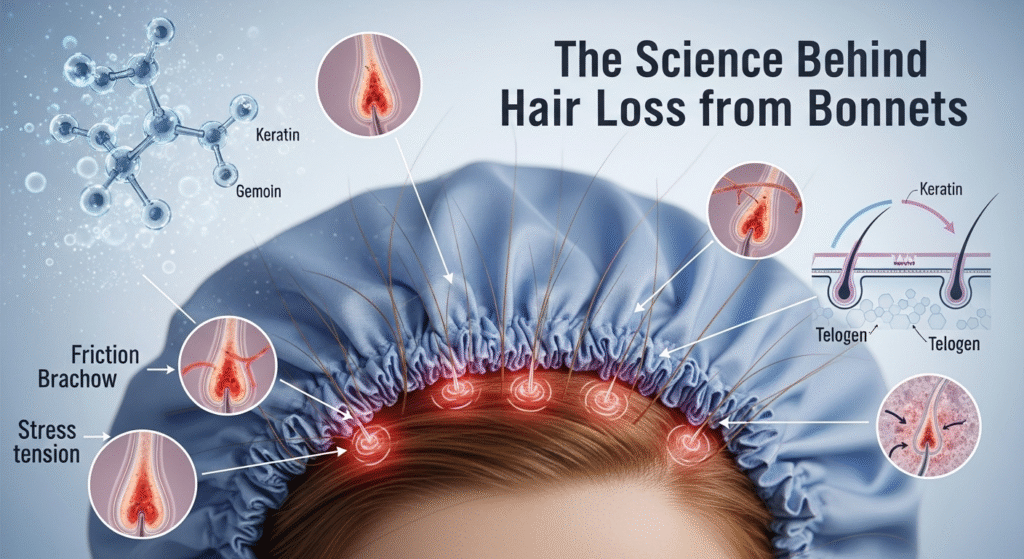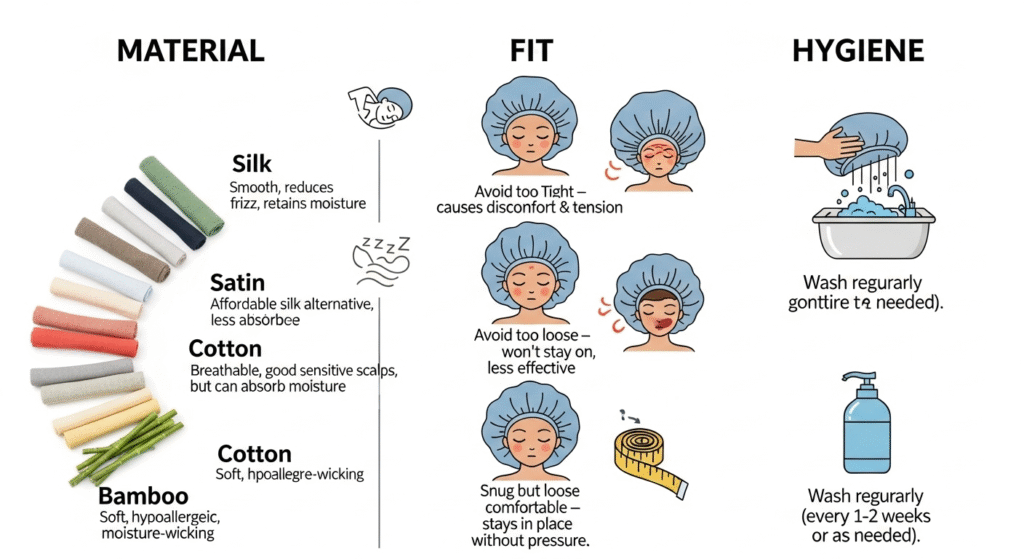In recent years, many people have asked: “can wearing a bonnet cause hair loss?” Bonnets and other sleep caps (often made of satin or silk) are popular tools for protecting hair at night. They minimize friction and help retain moisture, aiming to prevent breakage and frizz. But do they really affect your hair growth or …
In recent years, many people have asked: “can wearing a bonnet cause hair loss?” Bonnets and other sleep caps (often made of satin or silk) are popular tools for protecting hair at night. They minimize friction and help retain moisture, aiming to prevent breakage and frizz.
But do they really affect your hair growth or health? In this article, we’ll examine the myths vs. reality of bonnet use, look at the science (traction and friction alopecia, scalp hygiene), and share real experiences and expert advice.

Myth vs Reality: Can Wearing a Bonnet Cause Hair Loss?
A common myth is that wearing any bonnet will automatically lead to hair thinning, especially along the hairline or “edges.” In reality, bonnets themselves are not inherently harmful.
In fact, specialists point out that the right kind of hair bonnet can help keep your hair safe from damage and loss. Satin or silk bonnets can minimize split ends and reduce breakage, helping you retain length.
The truth is that hair loss tends to come from how a bonnet is used, not the bonnet per se. For example, an overly tight bonnet or one with a rough elastic edge can create traction and friction on the same strands all night. This constant pulling or rubbing can stress the hair follicles at the edges, causing traction alopecia.
A hair expert notes that only improper use of bonnets – like a tight fit or abrasive fabric – risks damage. So: bonnets can be a protective tool if chosen and worn correctly, but tight or ill-fitting ones may lead to hairline stress.
The Science Behind Hair Loss from Bonnets

On a biological level, there are two main concerns with any head covering: traction alopecia and frictional alopecia. Traction alopecia is hair loss caused by repeated pulling or tension on the hair. Dermatologists define it as hair loss from pulling on hair (think very tight styles or caps). Over time, tension weakens and breaks hairs, often near the temples or hairline.
Frictional alopecia is hair loss caused by constant rubbing. It can occur when hair rubs against surfaces night after night. Clinical sources note that repeated friction on hair or scalp can lead to hair loss in that area.
For example, rubbing clothing or pillowcases against the same spot can erode the hair shaft. Unlike scar-based baldness, these are “nonscarring” and often reversible if caught early.
Another factor is scalp hygiene. If a bonnet isn’t washed regularly, sweat, oil and product residue can build up under it, irritating hair follicles. Hair-care brands warn that bonnets “can end up with a buildup of bacteria and oil if they’re not washed. This debris can make it harder for your hair to stay healthy, raising the risk of damage”.
In short, a clean bonnet promotes a healthier scalp, while a dirty one can trap irritants. Dermatology resources advise regular cleaning: “Regular cleaning keeps your bonnet free from oils, dirt, and bacteria, promoting a healthy scalp and hair”.
Real User Experiences:
Online forums and hair communities are full of anecdotes. Some users report hairline thinning they associate with bonnets. My hairline had started to thin and break too… My hair line started to improve after that.”. Another said, “I wear a satin bonnet and it breaks my hairline. I think it’s the material around the bonnet… I kicked my bonnet to the curb at night and use a satin pillowcase.”.
These stories suggest that elastic bands or too-tight edges were the culprits, not the bonnet shape itself.
Conversely, other users share success stories. One long-time bonnet-wearer says she’s “been using a satin bonnet for 2 years with zero breakage” by ensuring the elastic band never touches her hairline. Many recommend wearing the bonnet inside-out so that the satin is against the hair, and swapping nights with a satin pillowcase or silk scarf. These real experiences highlight that adjustment – not giving up on bonnets – often solves problems.
Expert Insights and Medical Guidance:
Dermatologists and trichologists generally support the use of satin or silk bonnets as part of a healthy hair routine. For example, the University of Iowa’s hair loss guide explicitly suggests wearing a satin bonnet or pillowcase at bedtime as a preventive tip.
Hair experts emphasize that satin or silk reduces mechanical stress: “Keeping your hair moisturized is essential… Satin bonnets help to lock in that moisture, so your hair stays hydrated and healthy overnight,” notes hairstylist Felicia Leatherwood.
Traction alopecia specialists note that breaking the cycle of tension usually allows regrowth. One authoritative review states that traction alopecia is “biphasic”: early stages are reversible, but chronic tension causes permanent scarring. This means catching the problem quickly is key.
Medical guidelines advise stopping the stressor and using gentle hair care. In some cases, dermatologists may recommend treatments like topical corticosteroids or minoxidil to reduce inflammation and stimulate regrowth in early stages. (Always consult a professional for personalized medical advice.)
Tips on Choosing the Right Bonnet (Material, Fit, Hygiene):

- Material: Opt for smooth, breathable fabrics. Satin or silk bonnets are best because they glide over hair. Studies show silk retains hair moisture better than cotton. Avoid cotton or coarse materials which can grip hair.
- Fit: The bonnet should fit comfortably, not squeeze. Choose bonnets without tight elastic bands at the edge. If the bonnet stays on with a soft tie or a satin-draped hem, it avoids pulling at the hairline. Experts advise going for an adjustable or loose-fitting bonnet to prevent excessive tension.
- Construction: Some bonnets have an inner satin lining with a gentle tie, covering the edge bands. Look for “no-crease” or “elastic-free” designs. A cap with a gentle drawcord or a “scrunchie-style” band can protect edges.
- Hygiene: Wash your bonnet regularly. Aim to clean it every 1–2 weeks (more often if you use lots of hair products. This prevents oil and dirt build-up. Use cold water and gentle detergent (even washable ones like satin can usually go in a delicate cycle). A clean bonnet ensures a healthy scalp. Also, replace your bonnet once it shows wear (thin or stretched areas) to keep it protective.
Alternatives to Bonnets:
If bonnets don’t suit you, there are other sleep-protection options:
- Satin or silk pillowcases: These are dermatologist-recommended. For instance, the UIHC advice page suggests using a satin pillowcase at bedtime as a low-risk protective measure. Health sources note that sleeping on satin reduces hair friction and breakage.
- Silk hair scarves or turbans: A silk wrap or scarf can cover your hair without tight bands. One hair forum user advises, “Try satin scarves… static causes hair breakage. I use satin scarves… and wrap nets.”.
- Hair nets or sleep caps: A loose mesh hair net (often called a “hair wrap net”) can hold braids or curls gently.
- Protective hairstyles: Pineapple updos, loose braids, or twists under a satin bonnet/silk scarf can shield hair. Even sleeping with your hair loosely gathered on top of your head (the “pineapple” method) on a satin pillowcase can prevent tangles.
These alternatives still focus on reducing friction and tension. Satin contact (whether via pillowcase, scarf, or bonnet) remains the key.
How to Recognize Damage and Recover:
Be on the lookout for early signs of damage along the hairline or at areas of tension. This may include: scalp tenderness, small bumps or pimples near the hairline, itching, or more hair on your pillow or brush than usual. You might notice broken hairs or a thinning fringe (“fringe sign”).
If you suspect traction or friction-related damage, stop the culprit immediately. Switch to loose styles and give your scalp a break. Most often, new hair growth will start after a few months. Studies and guidelines report that hair regrowth typically begins around 3 months after eliminating the stresso.
A UK clinical resource notes that if tight hairstyling is stopped early, the hair can completely regrow‘
In practice, expect a gradual timeline: for example, by 3–4 months you may see stubble or fine hairs returning. By 6 months, those areas should thicken significantly if the follicles aren’t permanently damaged. If damage persists, treatments like gentle corticosteroid creams or topical minoxidil may be prescribed to support regrowth.
However, if the problem has gone on for years, the follicles may have scarred and require surgical options (consult a dermatologist for diagnosis and care).
Case Study/Timeline Example:
To illustrate recovery, imagine a person who noticed receding edges after years of tight styling. Once they stopped wearing tight bonnets and relaxed hairstyles, they followed a gentle care routine. According to clinical guidance, this person might see hair reappearing in about 3 months.
By 6 months, the hairline thickens visibly. At 1 year, if follicles were undamaged, their hairline often looks nearly back to normal. In contrast, if someone had worn traction-causing styles for 5+ years, some areas may remain thin even after stopping (due to permanent follicle loss). This timeline underscores how early intervention leads to better regrowth.
FAQs:
Can any bonnet cause hair loss?
Only if it’s used improperly. A loose satin or silk bonnet generally protects hair from breakage. Hair loss tends to occur when a bonnet is too tight, has rough elastic, or isn’t clean.
How should I fix edge breakage from a bonnet?
Stop wearing it tightly and switch to silk/satin immediately. Use a wide satin scarf or pillowcase at night and try gentle edge oils (like castor oil) on your hairline. If edges were stressed, give them a few months and avoid tension.
Is a satin bonnet better than cotton?
Yes. Satin/silk causes far less friction than cotton. Cotton can drag on hair and absorb moisture, leading to dryness. Satin keeps hair smoother and more hydrated overnight
How often should I wash my bonnet?
Ideally every 1–2 weeks, or whenever product build-up is noticeable. Clean fabric means a healthier scalp.
What type of bonnet is safest for edges?
Look for bonnets with no elastic band at the rim. Some brands make adjustable satin caps or “edge-friendly” bonnets that avoid pulling the hairline. Soft scrunchie-style bands or drawstrings are good options.
I’m still losing hair. Should I see a doctor?
If you notice significant thinning or bald patches, yes. A dermatologist or trichologist can determine if it’s traction alopecia or another condition. Early treatment improves chances of regrowth
Book a Consultation:
If you’re concerned about hair loss, don’t wait. Whether you’re in Islamabad or elsewhere,book your consultation with Dr. Uzma Irfan, an ISHRS-certified surgeon in Islamabad today. Dermatologists and hair specialists can assess your scalp and tailor treatments. For example, in Islamabad you can book a hair loss consultation with certified trichologists and dermatologists.
Taking action early will give you the best chance to recover your hair health. Empower yourself with knowledge and professional guidance – hair loss can often be managed successfully with the right help and routine.






